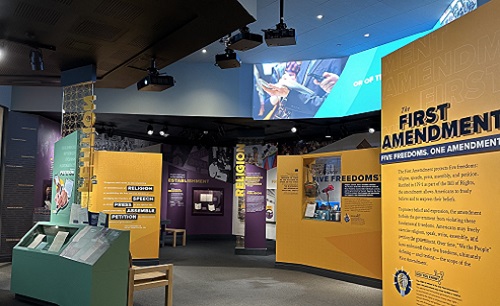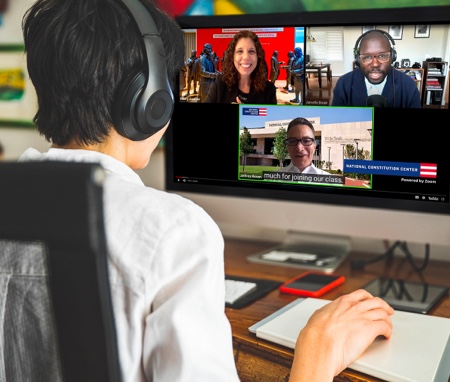
Constitution 101 Course
Start your constitutional learning journey


Article II of the Constitution establishes the executive branch of the national government, headed by a single President. Article II outlines the method for electing the President, the scope of the President’s powers and duties, and the process of removing one from office. The President’s primary responsibility is to carry out the executive branch’s core function—namely, enforcing the nation’s laws. From the debates over how to structure the Presidency at the Constitutional Convention to modern debates over executive orders, this module will explore the important role of the President in our constitutional system.
Purpose
Article II “vest[s]” the “executive Power . . . of the United States” in a single president. It sets out the details for how we elect a president (namely, through the Electoral College) and how we might remove one from office (namely, through the impeachment and removal process). It also lists some of the president’s core powers and responsibilities. In this activity, you will explore the role of the president in our constitutional system.
Process
Read the first line of Article II of the Constitution.
The executive Power shall be vested in a President of the United States of America.
Think about executive power and participate in a class discussion facilitated by your teacher. Answer the following questions:
After discussing the first line of Article II with your class, brainstorm a current list of roles/jobs for the president. Record them and share with your classmates.
Review the Info Brief: Presidential Roles document for a comprehensive list.
Launch
Provide students with a summary of the three branches of government. Within the national government, the executive branch is responsible for enforcing the laws. We commonly think of the president as the most powerful elected office in all of the world. Yet, the Constitution actually grants far fewer explicit powers to the president in Article II than it does to the Congress in Article I.
Give students time to read the first line of Article II.
Over the course of the week, ask students to try to match some of the key jobs of the president with what is spelled out in the Constitution.
Note: The 22nd Amendment limits the president to two terms in office. This is an example of a norm established by George Washington, held over time, violated by Franklin Delano Roosevelt, and then written into the Constitution. This is a great example to share with students of how a presidential norm may be written into the Constitution.
Activity Synthesis
Ask students to discuss recent presidents and the roles they took on during their terms in office.
Activity Extension (optional)
Now that students have a better understanding of the roles/jobs of the president, ask them to find a news article that demonstrates one or more roles of the president.
You can also ask students to speak to at least two adults and two peers outside of class, ask them the following questions, and write down their responses.
Purpose
In this activity, you will continue to explore the presidential jobs that are spelled out by the Constitution.
Process
Review the text of Article II and the Interactive Constitution essays on Article II - The Executive Branch to help complete the Activity Guide: How does the Presidency Work? worksheet.
Review the following sections in the Constitution and the Interactive Constitution Common Essays:
Compare your worksheet to the list you created as a class in the previous activity. Be prepared to discuss the similarities and differences as a class.
Launch
Give students time to identify from memory as many roles/jobs of the president as they can remember from the previous activity. Compare that list to the list of roles/jobs that the adults and peers they asked identified.
Direct students to the text of Article II and the Interactive Constitution essays on Article II - The Executive Branch. Build a list of powers and duties for the president. Then, compare the crowdsourced list with the list developed from the primary and scholarly sources (the Constitution’s text and the Constitution essays).
Review the following sections in the Constitution:
Activity Synthesis
When the comparison is complete, students could build a “Job Posting Advertisement” for a presidential candidate. Have students share ads with their classmates for review and discussion.
Activity Extension (optional)
Review the resumes/background of several former presidents. Do you notice any patterns among the presidents? Does anyone stand out as having a unique background?
Purpose
In this activity, you will view a video on the presidency and what the Constitution says about it.
Process
Watch the following video about the presidency.
Then, complete the Video Reflection: The Presidency worksheet.
Identify any areas that are unclear to you or where you would like further explanation. Be prepared to discuss your answers in a group and to ask your teacher any remaining questions.
Launch
Give students time to watch the video and take notes to support their notetaking skills.
Activity Synthesis
Have students share their notes with a classmate and then review as a class.
Activity Extension (optional)
Now that students have a better understanding of the presidency, ask them to identify what informal qualifications a president should have to be successful.
Purpose
The delegates engaged in many debates over the presidency. One key debate involved the issue of how to elect the president. Today, many democratic nations elect their executives by direct popular vote. But we don’t. Instead, we use a system known as the “Electoral College.”
In this activity, you will read two sources to understand the founders’ debates over how to elect a president and their vision for the Electoral College. You will also reflect on the Electoral College now versus back when it was created.
Process
Launch
Give students time to read the briefing sheet on the Electoral College and watch this short video.
Review the key readings and debates and then examine the ideas and compromises as a group.
Activity Synthesis
Have students share their thoughts about the proposals for how to elect a president and discuss positive and negative aspects of each. Ask students if they think the Electoral College, as it functions today, should be eliminated, changed, or stay the same.
Activity Extension (optional)
Have students run for president and then have the rest of the class divided into the states to vote for their preferred candidate, replicating the Electoral College. Have each candidate select (or select for them) a campaign manager. The campaign manager's job is to build a strategy for targeting which states they think will be most useful to gain the electoral votes needed. Have the campaign teams visit only five groups of students (replicating scarcity of time and money on the campaign trail), making strategy a key component in securing victory. Have students vote by state groups and individually to examine who wins the popular vote and who wins the Electoral College.
Purpose
There are still many ongoing debates over presidential power. When it comes to presidential power, the core constitutional question often comes down to this: Can the president do that? Over time, the Supreme Court has provided some guidance on how to analyze this important question.
In this activity, you will examine a major test of presidential power, the Supreme Court’s landmark decision in Youngstown Sheet & Tube Co. v. Sawyer (1952), also known as “The Steel Seizure Case.”
Process
Begin by reading excerpts from Primary Source: Youngstown Sheet & Tube Co. v. Sawyer (1952) and reviewing your notes from Activity 8.3 and reference your notes from the Info Brief: Methods of Constitutional Interpretation from module one. If you would like to watch the video again, starting at timestamp 12:25.
This landmark case took place during the Korean War. Steel workers were going on strike and President Truman responded by seizing the steel mills. He argued that a steel strike was a threat to national security because the Army needed steel to conduct the war. Therefore, he had the constitutional authority to act on his own—in other words, without explicit congressional approval—under his Article II commander in chief power.
After reviewing the primary source and video, complete the Case Brief: Test of Presidential Power worksheet.
Launch
Give students time to read excerpts from Primary Source: Youngstown Sheet & Tube Co. v. Sawyer (1952), review your notes from the earlier video, and answer the questions provided.
Activity Synthesis
Have students share their responses to the questions and discuss as appropriate.
Ask students how the presidency today compares to the founders’ vision.
Activity Extension (optional)
Have students review other court cases related to presidential power.
Purpose
One of the key debates over presidential power today involves the president’s use of executive orders. Defenders of presidential power argue that executive orders are central to the president’s core responsibilities of overseeing the executive branch and enforcing laws already passed by Congress. Critics of presidential power often argue that presidents (of both parties) use executive orders to stretch their powers—using them to command executive-branch officials to promote policies that they can’t get Congress to enact into law. In this activity, you will examine executive orders and how they have evolved over time.
Process
In your group, review the following resources:
Record your answer to the following questions and prepare to discuss.
Then, review Activity Guide: Quotes on Visions of Presidential Power. Try to guess which quote belongs to which key historical figure. As a class, compare the different viewpoints on presidential power.
Launch
Give students time to review executive orders resources and answer the questions. Three sources to review are as follows:
Activity Synthesis
Have students record their answer to the following questions and review as full class.
Ask students to summarize the information from the lesson in three to five sentences.
Activity Extension (optional)
When it comes to presidential power, the constitutional question often comes down to this: Can the president do that?
Discuss the following examples with your class.
Review a news item about executive orders today and see what leading questions are being posed on the balance of executive powers.
Purpose
Congratulations for completing the activities in this module! Now it’s time to apply what you have learned about the basic ideas and concepts covered.
Process
Complete the questions in the following quiz to test your knowledge.
Launch
This activity will help students determine their overall understanding of module concepts. It is recommended that questions are completed electronically so immediate feedback is provided, but a downloadable copy of the questions (with answer key) is also available.
Article III of the Constitution establishes the judicial branch of the national government, which is responsible for interpreting the laws. At the highest level, the judicial branch is led by the U.S. Supreme Court, which consists of nine Justices. In the federal system, the lower courts consist of the district courts and the courts of appeals. Federal courts—including the Supreme Court—exercise the power of judicial review. This power gives courts the authority to rule on the constitutionality of laws passed (and actions taken) by the elected branches. The Cons...


Explore our new 15-unit core curriculum with educational videos, primary texts, and more.

Search and browse videos, podcasts, and blog posts on constitutional topics.

Discover primary texts and historical documents that span American history and have shaped the American constitutional tradition.